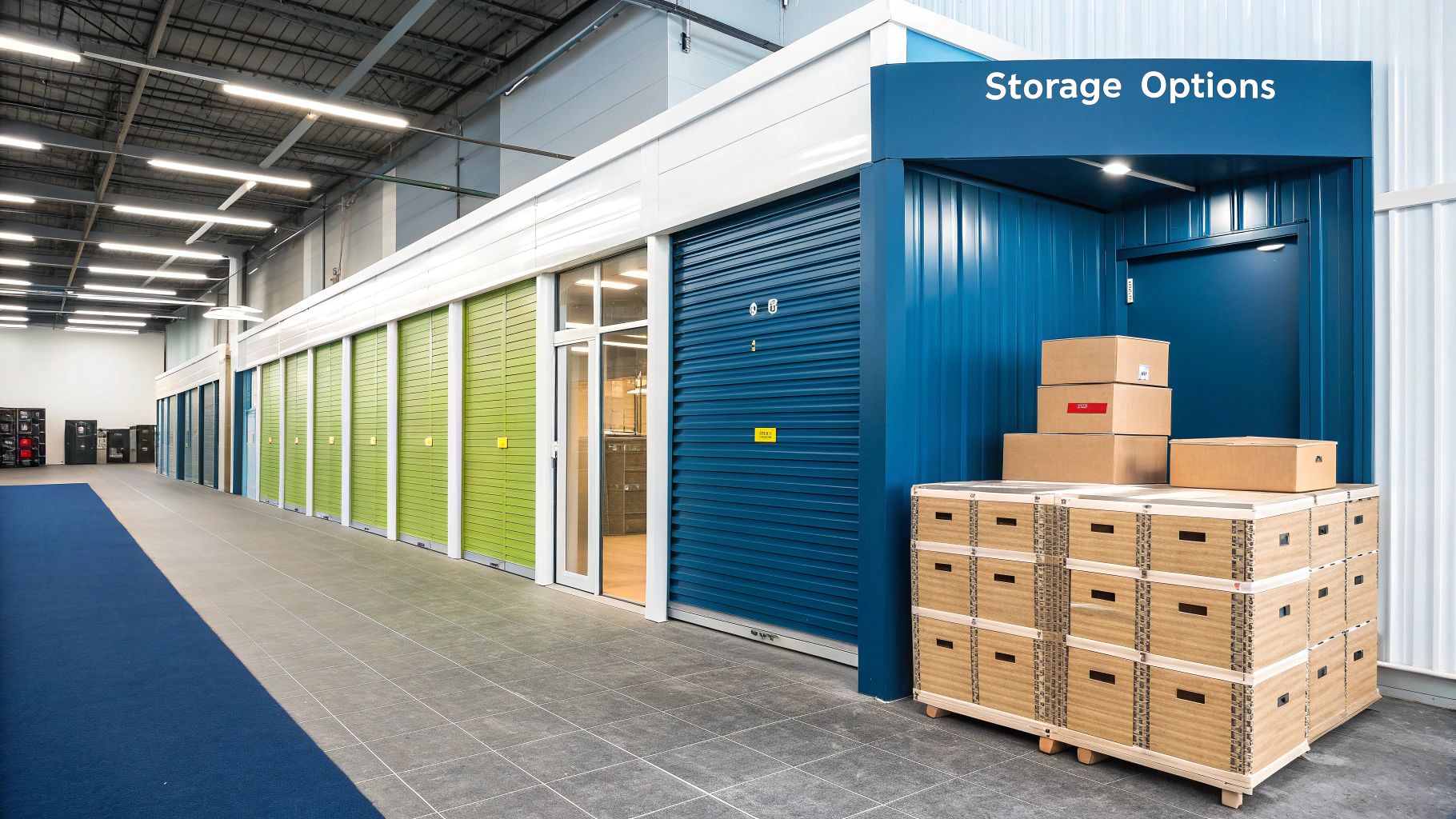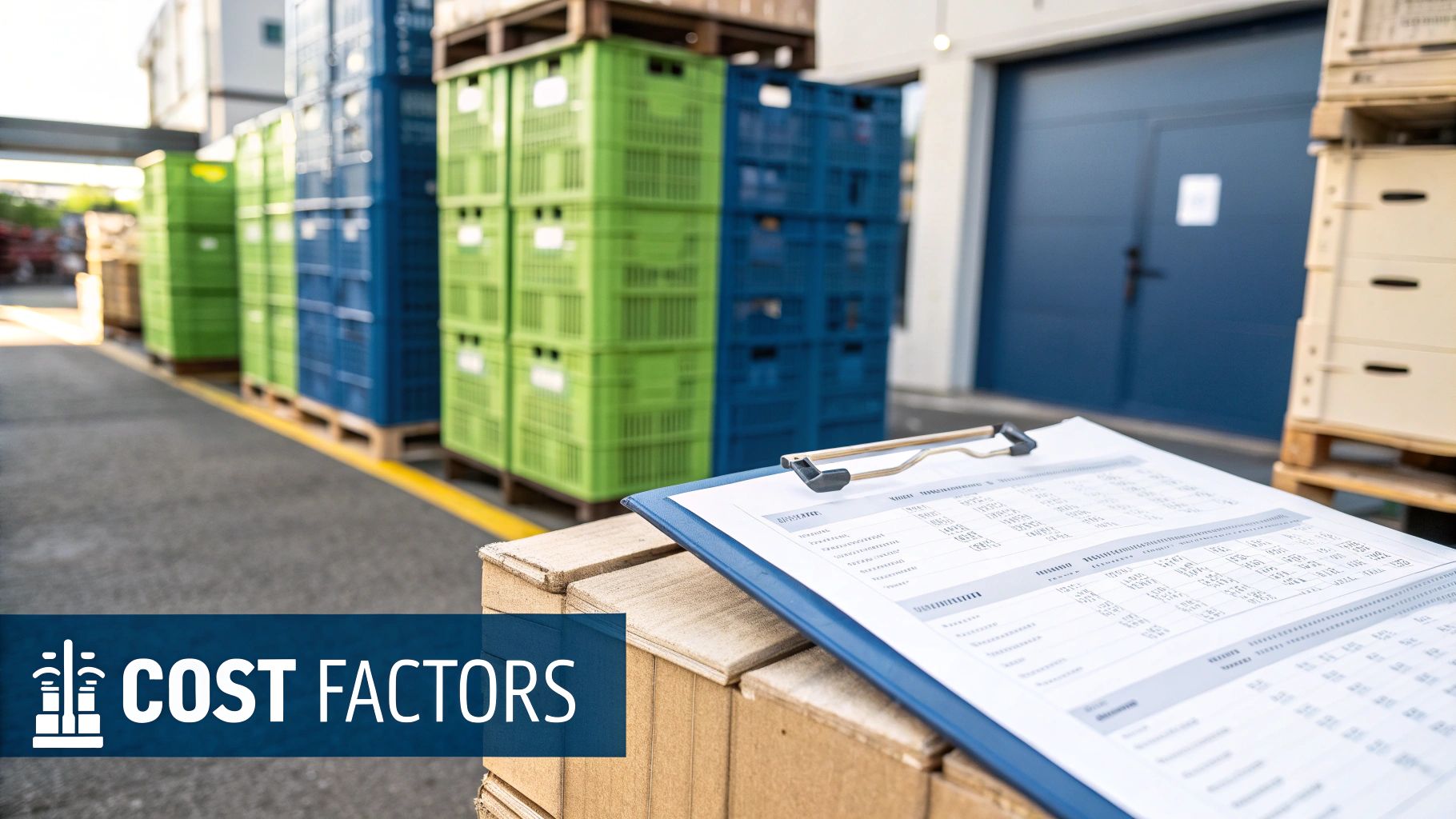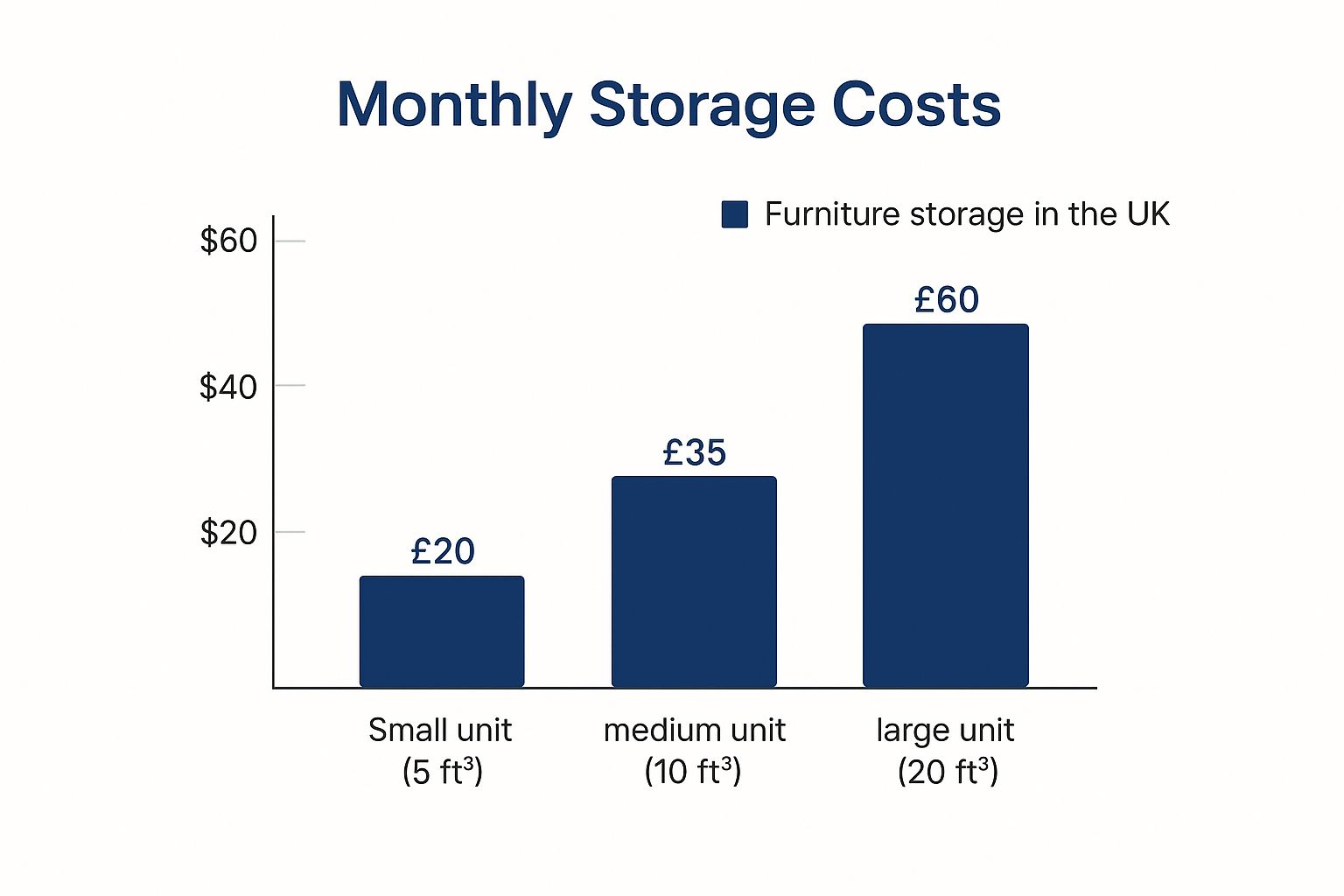So, you need to store some furniture. The big question on your mind is probably, "How much is this going to set me back?"
The short answer is that the average cost of furniture storage in the UK typically falls somewhere between £50 and £250 per month. But that's a pretty wide range, isn't it? The final price you pay really boils down to a few key things: how much space you need, where you are in the country, and what kind of features you're looking for.
Your Quick Guide to UK Furniture Storage Costs



Trying to figure out the exact cost of storing your furniture can feel like trying to hit a moving target. Is £100 a month for a medium-sized unit a good deal or a rip-off? Well, it depends. Let’s break down the factors that will give you a much clearer picture.
Think of it like finding a temporary home for your belongings. Just as house prices are worlds apart from one region to the next, storage costs follow the same pattern. A unit in the heart of London is naturally going to cost more than the same size space in Leeds or Bristol. It’s all about location, location, location.
The need for storage often pops up during big life changes. For instance, navigating the UK house buying process step by step can create an awkward gap between selling your old place and getting the keys to the new one. That's when temporary storage becomes a real lifesaver.
Key Cost Considerations at a Glance
Before we get into the nitty-gritty later on, let's cover the basics. The main things that will shape your monthly bill are:
- Unit Size: This is the big one. The more space you need, the more you'll pay.
- Location: City centre facilities almost always cost more than those in suburban or rural areas.
- Rental Duration: Committing to a longer-term contract can often unlock some decent discounts.
- Access & Security: If you need 24/7 access or a facility with high-tech security, expect to pay a bit more for the convenience and peace of mind.
The demand for reliable storage solutions has led to huge growth in the UK's self-storage industry. In fact, total floorspace shot up by 7.2% last year, hitting a massive 64.3 million square feet, according to the latest SSA UK Annual Report. This expansion means more choice for you, but also highlights just how many people are in the same boat.
Getting a handle on these variables is your first step. For a closer look at how to keep your items safe and sound, check out our guide on secure furniture self-storage. Once you understand these core concepts, you'll be able to compare quotes confidently and find a unit that’s the perfect fit for both your things and your budget.
Estimated Monthly Furniture Storage Costs in the UK
To give you a clearer idea of what to expect, we've put together a table outlining typical monthly costs for different unit sizes across the UK. Think of this as a starting point for your budgeting.
| Unit Size (sq ft) | What It Typically Holds | Average Monthly Cost (Low End) | Average Monthly Cost (High End) |
|---|---|---|---|
| 25-35 | Contents of a studio flat or a large garden shed (boxes, small furniture) | £50 | £90 |
| 50-75 | Contents of a 1-2 bedroom flat (sofas, beds, white goods) | £90 | £160 |
| 100-125 | Contents of a 2-3 bedroom house (multiple large furniture items) | £160 | £230 |
| 150+ | Contents of a 4+ bedroom house or for small business inventory | £230 | £300+ |
Remember, these are just estimates. Prices in major cities like London will lean towards the high end, while you'll find more competitive rates in other parts of the country.
What Really Drives Your Storage Quote?



The size of your unit is a big piece of the puzzle, but it’s certainly not the whole story. Several key factors come together to shape the final cost of furniture storage in the UK. Getting to grips with these drivers helps you look past the advertised price and see what you're actually getting for your money.
It’s a bit like booking a hotel. A basic room in a quiet town will have a very different price tag than a luxury suite in a bustling city centre, even if they’re technically the same size. The same logic holds true for storage, where convenience, location, and extra perks all nudge the final price up or down.
Location: The Property Market of Storage
After size, the single biggest influence on your storage quote is the facility's postcode. A unit right in the heart of a city like London or Manchester will always cost a premium, reflecting the higher land values and running costs in those areas.
Head out to a facility on the edge of town or in a more rural spot, and you'll almost always find more budget-friendly rates. The difference can be pretty significant, so choosing a facility just a few miles further out could lead to some serious monthly savings. The key question to ask yourself is: how often will I really need to get to my things? If it’s only now and then, a less central location is a smart way to cut costs.
Contract Length and Added Features
Just like with a flat rental, the length of your stay matters. Many facilities are happy to offer discounts for longer commitments, so paying for six or twelve months upfront can often work out cheaper than a flexible, rolling monthly contract.
Beyond that, the little extras can also add up. These features are all about convenience and giving you peace of mind, but they come at a cost.
- 24/7 Access: If you want the freedom to pop in whenever you like, day or night, expect to pay a bit more than you would for standard 9-to-5 access.
- Enhanced Security: Top-tier facilities with individually alarmed units, key-coded gates, and comprehensive CCTV will naturally charge more for that extra layer of protection.
- Climate Control: Essential for protecting delicate wooden furniture, antiques, or electronics from damp and temperature swings. A climate-controlled unit costs more, but it's a price worth paying for valuable items.
When you get a quote, you're not just renting square footage. You're paying for a whole package: the location, the ease of access, and the level of security. Breaking down these components is the secret to finding the best value for your specific situation.
A Look at Storage Prices Across the UK
When it comes to the cost of furniture storage in the UK, your postcode plays a surprisingly big role. Just like the property market, storage prices can vary wildly depending on where you are in the country, from the heart of a major city to a quieter market town.
Think about it this way: renting a storage unit in central London could easily set you back nearly double what you’d pay for the exact same space in Leeds or a town further north. This isn't random; it's all down to local demand, the cost of running the facility, and of course, land value. Getting to grips with this geographical lottery is the first step to finding a deal that works for you.
Big Cities vs. The Countryside
It’s no surprise that in densely populated areas, especially London and the South East, high demand and a simple lack of space send prices soaring. Rates in these regions are consistently the highest in the UK. On the flip side, you'll often find more competitive pricing in the North of England, Scotland, and Wales, which can lead to some serious savings.
This regional difference is something you can use to your advantage. If you don't need to pop in and out of your unit every other day, looking at a facility just a few miles outside a major city centre can dramatically lower your monthly bill without skimping on quality or security. For businesses needing regular access, it's a bit more of a balancing act between convenience and cost. Many companies find that exploring dedicated business storage units helps them get a better handle on their logistical spending.
This chart gives you a quick visual on how monthly costs can stack up for different unit sizes across the country.



As you can see, the jump in price between sizes is pretty significant, which really hammers home the importance of not paying for space you don't need.
A Regional Price Snapshot
To make this crystal clear, let's look at what you might expect to pay for a standard 75 sq ft unit. This is a popular size, generally big enough to hold the contents of a one or two-bedroom flat.
Here’s a rough guide to how those monthly costs compare across different parts of the UK.
Average Monthly Storage Cost by UK Region (For a 75 sq ft Unit)
| Region or Major City | Estimated Monthly Cost Range |
|---|---|
| London (Central) | £180 – £260+ |
| South East England | £150 – £220 |
| Manchester | £120 – £170 |
| Birmingham | £110 – £160 |
| Scotland (Glasgow/Edinburgh) | £100 – £150 |
| North of England | £95 – £140 |
| Wales | £90 – £130 |
One thing to keep in mind is that these figures are averages. The final price can shift based on the specific facility, its features, and how full they are at any given time. It always pays to get a direct quote to know exactly what you'll be paying.
Still, the table makes it obvious: a short drive could genuinely translate into big savings on your monthly storage bill.
What Are the Hidden Costs of Storage?
The monthly rate you’re quoted for a storage unit is really just the starting point. To get a true picture of the cost of furniture storage in the UK, you have to dig a bit deeper than the headline price and be ready for the extra charges that can easily inflate your bill.
It's a bit like buying a car. The sticker price gets you the basic model, but the features you actually need—like reliable insurance and a high-quality lock—often come as add-ons. Every facility has its own set of rules, and if you’re not asking the right questions from the get-go, you can get caught out by unexpected fees.
The demand for storage tracks closely with the UK furniture market, now a massive £18 billion industry. As more of us move into smaller city homes, the need for external storage has boomed. This makes it more important than ever to know exactly what you'll be paying for.
Common Add-Ons to Watch For
First on the list is usually insurance. Almost every storage provider will insist your goods are covered, but that doesn't mean you have to buy their policy. It’s always a good idea to research typical storage insurance costs and see if you can get a better deal from a third-party insurer.
Here are a few other potential fees to keep an eye on:
- Security Padlocks: Some places will require you to buy one of their specific high-security padlocks instead of letting you bring your own.
- Administration Fees: A one-time setup fee is pretty common. Always ask if this is rolled into your initial quote or if it’s an extra charge.
- Security Deposits: Just like renting a flat, you'll often need to pay a refundable deposit to cover any potential damages or missed payments.
The best way to avoid hidden fees is to demand transparency. A good storage company will be completely upfront about all potential costs, from insurance policies to one-off setup charges, so there are no nasty surprises for your budget down the line.
Access Hours and Service Charges
How and when you need to get to your things can also add to the cost. Standard access during normal business hours is typically included, but if you need to pop in during the evening or on a weekend, you might face an extra fee.
This is especially critical if you're in the middle of a big move. Our guide on using self-storage when moving home is packed with tips to make that process go smoothly. Before you sign anything, make sure you're crystal clear on the access hours and any charges that come with them, ensuring the arrangement works for both your schedule and your wallet.
How the Economy Shapes Your Storage Bill
The price you pay for furniture storage doesn't exist in a vacuum. It's directly tied to the wider economic climate, from the buzz of the property market to the nuts and bolts of national supply chains. Understanding these connections can help make sense of why the cost of furniture storage UK can shift from one year to the next.
It’s a bit like the price of petrol at the pump; global events and supply hiccups can cause swings that feel completely out of your hands. The storage industry is much the same, reacting to the economic weather and, in turn, passing those changes on to customers.
The Housing Market's Influence
Here in the UK, the property market is a massive driver of storage demand. When the market is booming and houses are changing hands quickly, you see a huge spike in people needing short-term storage to bridge that awkward gap between moving out and moving in.
But a cooler housing market can have a surprisingly mixed effect. Sure, fewer people might be moving, but others decide to put their belongings into long-term storage while they wait for better conditions to sell or buy. This creates a different, more sustained kind of demand.
Economic shifts have a direct impact. For instance, high mortgage rates tend to dampen the demand for storage related to moving house. Yet, the overall need for space remains strong, thanks to things like working from home and the endless quest to declutter. In fact, businesses now account for roughly a third of all occupied units. You can dive deeper into these market dynamics in the latest industry report from the SSA UK.
Getting a feel for the economic landscape gives you a strategic advantage. It helps you anticipate where prices might be heading and decide whether it’s a good time to lock in a long-term rate or stick with a more flexible plan.
Supply, Demand, and Building Costs
Beyond the housing market, it all comes down to basic supply and demand. The cost of land, materials, and labour needed to build new storage facilities has shot up recently. Naturally, these higher construction costs get baked into the rental prices for the new units.
When there are more people needing storage than there are available units in a particular area, prices will inevitably climb. This is exactly why you'll often find steeper rates in densely populated city centres, where space is a precious commodity and building a new facility is a major investment for providers.
Practical Ways to Lower Your Storage Costs



Knowing what drives the cost of furniture storage UK is the first step, but the real power comes from using that knowledge to actively cut your monthly bill. With a bit of smart planning, you can get the right space without paying over the odds. This is about making savvy decisions from the get-go.
Think of it like booking a holiday – the price you pay can vary wildly depending on when and how you book. Being proactive, asking the right questions, and not just grabbing the first quote you see can lead to some serious savings. A few simple tweaks to your approach can make all the difference.
Declutter Before You Store
Honestly, the most effective way to save money on storage is to store less stuff. It’s that simple. Before you start looking for quotes, commit to a proper clear-out of everything you plan to put away. Be tough with yourself. If something is broken, you haven’t used it in years, or you just don’t love it anymore, it’s time to sell, donate, or recycle it.
Every square foot in a storage unit has a price tag. Paying monthly to keep hold of items you’ll probably get rid of later is just throwing money away. Reducing the volume of your belongings might mean you can fit everything into a smaller, cheaper unit, cutting your costs right from day one.
The goal is to pay only for the space you genuinely need. A weekend spent decluttering before you move items into storage can save you hundreds of pounds over the course of your rental period.
Be Smart with Your Booking Strategy
Your timing and commitment can be surprisingly powerful tools when it comes to getting a better deal. It’s always worth looking for introductory offers, but make sure you read the small print to see what the price jumps to after the promotional period ends.
Here are a few tactics that can help you secure a better rate:
- Book Online: Many storage companies offer special discounts that are only available when you reserve your unit through their website.
- Commit to a Longer Term: If you're certain you’ll need the unit for six months or more, ask about discounts for pre-payment. Paying for a longer block upfront often brings the average monthly cost down.
- Be Flexible on Location: As we’ve seen, prices can drop significantly once you move away from prime city-centre locations. If you don't need to pop in every other day, choosing a facility a few miles further out could slash your bill.
By thinking like a savvy shopper, you can take control of your storage costs. Exploring the many benefits of self-storage is far more satisfying when you know you’ve found the best possible value for your needs.
Your Questions, Answered
To finish up, let's dive into a few of the questions we hear all the time about storing furniture in the UK. Getting these details straight can make all the difference as you finalise your plans.
Do I Really Need Special Insurance for My Stored Furniture?
Yes, you'll almost certainly need insurance, but you don't always have to buy it from the storage company itself. The first port of call should be your current home insurance provider. Give them a ring and see if your policy covers items you've placed in an off-site storage unit.
If it doesn't, then you'll need a separate policy. While buying one directly from the storage facility is easy, it's worth shopping around. A quick search with third-party insurers could land you a much better deal. Just make sure you know the minimum cover the facility insists on before you sign up.
Taking a moment to sort out your insurance is a huge part of controlling your overall storage costs. Don't just tick the box on the first policy you're offered; a quick phone call or online search could save you a good chunk of money.
What’s the Right Size Unit for a Two-Bedroom House?
For the contents of an average two-bedroom home, you’re usually looking at a unit around 75 to 80 sq ft. This typically gives you enough room for the big stuff—sofas, beds, a fridge-freezer—plus a decent number of boxes.
That said, guessing is a risky game. It's far better to use the storage company's online size calculator or even measure your largest pieces of furniture yourself. Honestly, it’s always smarter to have a little too much space than to find yourself trying to cram everything into a unit that’s just too small, risking damage to your belongings.
Are There Cheaper Options Than a Standard Self-Storage Unit?
Absolutely, but what you save in money you often trade in convenience, security, or protection.
- Container Storage: This is often the cheapest route per square foot. The downside? They’re usually just big metal boxes, so there’s no climate control. This can be a real problem for wood furniture or delicate items. Security can also be less sophisticated than at a proper indoor facility.
- Collection-Based Storage: Here, a company comes to you, packs your things into crates, and takes them to a warehouse. It’s incredibly convenient upfront, but getting access to your items later can be a hassle, often requiring you to book an appointment well in advance. The fees for this convenience can also add up.
Ready to find a secure, affordable, and straightforward storage solution for your furniture? At Admiral's Yard Self Storage, we believe in clear pricing with no hidden surprises. Get a free, no-obligation quote online today and discover how simple storage can be.



